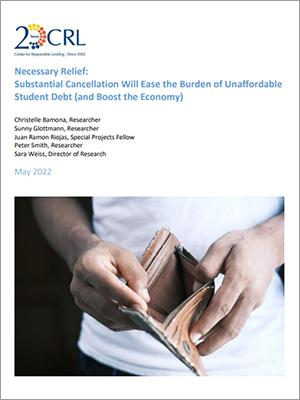The student debt crisis has been building for decades, and millions of families have seen their dreams derailed by unaffordable debt repayment burdens that block their path to financial stability. As college costs rose, students had to take on increasing amounts of debt to pay for higher education. At the same time, state student financial aid offerings were drastically reduced, forcing students and families into long term debt that often grew to be unaffordable over time.
Due to longstanding discrimination, students and families of color have less personal, family, and intergenerational wealth, forcing them to take on more college debt. Many were targeted by predatory for-profit educational institutions that saddled them with debt while providing a substandard education that did not increase their job prospects or earning power. Graduates of color from traditional colleges carried more debt and often faced diminished job prospects, especially over the course of the Great Recession and the Covid pandemic. For example, today Black women hold median student debt burdens that are two-thirds higher than for white men. Yet due to pervasive pay discrimination, even highly educated Black women earn only 65 cents for every dollar earned by white males.
Pay disparities are one reason much of the more than $1.7 trillion of student debt outstanding cannot be repaid. This debt burden prevents millions of American taxpayers from meeting day-to-day family needs, much less buying a home or starting businesses. It also depresses our overall economy, at a time when we badly need to boost and expand sources of economic growth.
The huge obstacle created by this massive debt requires a commensurate intervention. To provide relief to the families and the overall economy, a substantial portion of student debt must be cancelled. Various proposals have called for debt relief ranging from $10,000 to $50,000 per borrower. This report analyzes the impact of such cancellation, adding analyses from two new data sources: a panel of credit records for more than 360,000 student borrowers and focus group analysis of women from across the country who had either voluntarily or involuntarily cut back their work hours or quit their jobs during the Covid-19 pandemic; and new analyses from the 2019 Survey of Consumer Finances (SCF).
The findings confirm that:
- Millions of families – despite diligently repaying their debts for a decade or more – remain trapped in unaffordable and growing debt balances. This is particularly the case for borrowers of color.
- When the temporary relief of the latest student loan payment pause ends, up to 15 million borrowers are projected to experience tremendous hardship.
- Cancelling $50,000 of student debt would deliver meaningful relief to a substantial number of borrowers caught in the student debt trap, eliminating debt for 72% of Black and Latino taxpayers and relieving a major source of racial wealth inequity.
- In contrast, cancelling the bare minimum of $10,000 only would reduce 22% of Black student debt, and 28% of Latino student debt.
